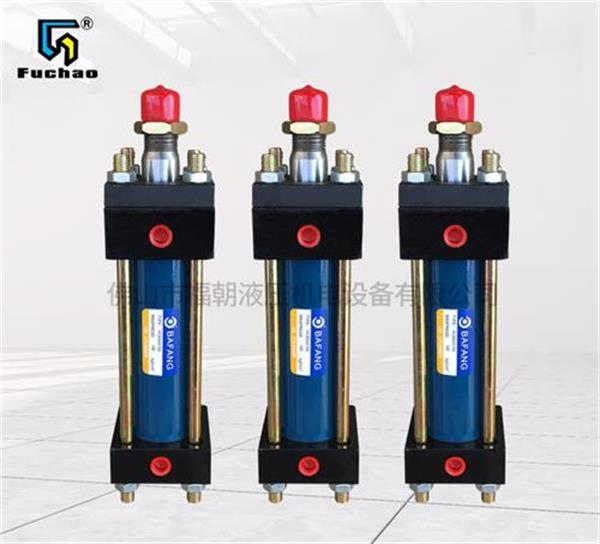When Hydraulic cylinder In case of leakage, the volume of the cylinder cavity will become smaller, the efficiency will be reduced, and even the system will not work. Therefore, necessary sealing measures shall be taken to avoid leakage of hydraulic cylinder.
The leakage of hydraulic cylinder includes internal leakage and external leakage. The external leakage mainly occurs between the piston rod and the cylinder head as well as the guide sleeve. The internal leakage mainly refers to the leakage between the outer wall of the piston and the inner wall of the cylinder barrel.

1、 The frequency response of hydraulic cylinder is closely related to the sealing form. At present, mature sealing methods of hydraulic cylinders include:
1. Seal
Install seals on the outer surface of the piston to prevent internal leakage. In this sealing mode, the sealing element is in close contact with the inner wall of the cylinder barrel, which can play a very good sealing effect. When the oil pressure increases, the contact pressure on the sealing surface will also increase, so that the sealing effect will be further improved.
Seal element sealing is a widely used sealing method at present, with high volume ratio and small internal leakage.
2. Combined seal
The rubber sealing components are used to realize the sealing function of the hydraulic oil cylinder, mainly including the Glee ring, the bud ring, and the Stuart seal. They have the characteristics of combined two seals, and play a sealing role together in the work. For example, the GREE ring, which is composed of rubber O-ring and PTFE GREE ring, has good elasticity and self lubrication of the O-ring, and has a longer service life.
picture
3. Clearance seal
This is a sealing method to prevent leakage by keeping a small gap between the mating surfaces of the two moving parts on the outer wall of the piston and the inner wall of the cylinder barrel, and generating liquid friction resistance by the flow resistance, tension between the oil and the mating surface, molecular force, etc.
The clearance seal is characterized by simple structure, low friction and high running speed of the piston. The disadvantage is that the internal leakage is large, especially when used for large diameter hydraulic cylinders, the internal leakage will increase sharply, affecting the volume ratio of hydraulic cylinders. Therefore, clearance seal is only applicable to hydraulic cylinders with smaller diameter and lower pressure.
2、 Variable clearance seal
At present, various sealing methods have their advantages, but also have problems that are difficult to solve. In recent years, scientific researchers have been committed to the structural optimization of hydraulic cylinders, in order to develop hydraulic cylinders with low leakage, low friction resistance, and high running speed.
The gap seal used now is a constant gap seal. In order to solve the problem that the constant gap seal has a large leakage and cannot be used in high pressure cylinders, someone proposed a sealing method of variable gap seal.
The core of variable clearance seal is to add an annular deformable lip structure at both ends of the piston. Its working principle is that when the oil flows to the high-pressure chamber of the cylinder, the piston lip and the inner wall of the cylinder form a throttling clearance. Due to the differential pressure flow and the shear flow between the piston and the inner wall of the cylinder barrel, the high-pressure oil flows from the high-pressure chamber to the low-pressure chamber through the gap between the lip and the inner wall of the cylinder block.
At this time, the pressure on the upper surface of the lip edge decreases gradually, and the lower surface is subject to high pressure. The pressure difference between the upper and lower surfaces of the lip edge makes the lip edge expand to the inner wall of the cylinder, and then it is balanced under the interaction of elastic force and pressure. At this time, the seal clearance is reduced and the leakage is reduced. Because the clearance is not completely eliminated, the friction pair between the piston and the inner wall of the cylinder can be lubricated by oil, and the friction performance and frequency response characteristics of the hydraulic cylinder can be improved.
3、 Advantages and development trend of variable clearance seal
The pressure compensation adaptive variable clearance seal structure is formed by using the pressure difference between the inner and outer walls of the lip when the hydraulic cylinder is working, which can effectively reduce the defect that the leakage in the constant clearance seal structure increases with the increase of the pressure difference. Especially under the high pressure difference, the variable clearance seal structure has a very obvious inhibitory effect on the leakage, which can improve the working efficiency of the hydraulic cylinder and reduce the energy loss. The sealing structure is simple, convenient for processing and manufacturing, and stable and reliable in operation.
The variable clearance seal also has shortcomings, that is, when the pressure difference is small, the leakage is large. If the pressure difference is too large, the piston lip will open too much outward, causing the piston to contact the inner surface of the cylinder, leading to lip deformation and failure.
In recent years, more and more people are committed to using new functional materials to improve the response speed of hydraulic components. In terms of the sealing performance of the hydraulic cylinder, someone innovatively proposed to use magnetic shape memory alloy (MSMA) to control the sealing clearance of the hydraulic cylinder by causing micro deformation between the hydraulic cylinder and the piston. The method is as follows: a plurality of annular grooves are designed at both ends of the piston, and several MSMA auxiliary support blocks are set in the grooves to form several clearance seal rings. MSMA has the characteristics of large recoverable strain (micro deformation), fast response speed and high cycle fatigue. It uses its electromagnetic driven expansion effect to reduce internal leakage by controlling the magnetic field and temperature.
Variable clearance seal greatly improves the life and frequency response of hydraulic cylinder, and further expands the application space. However, the variable clearance sealing technology is not yet mature and is still in the early stage of research. It is believed that in the near future, with the application of these new technologies, the leakage of hydraulic cylinders can be improved.



